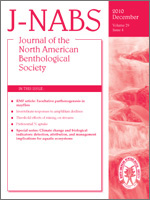If organisms move beyond the boundaries of local sampling units, regional metacommunity dynamics could undermine the ability of bioassessment studies to characterize local environmental quality. We tested the prediction that fish dispersal influences local fish community structure and bioassessment metrics as a function of site position within stream networks. We evaluated fish community data from the US Environmental Protection Agency's Regional Environmental Monitoring and Assessment Program in West Virginia, USA, to compare the influences of stream network position, ecoregion, basin, and stream size on local fish community composition. We assigned sites to 1 of 3 stream network positions: 1) main channels (MC, n = 12) encompassed streams with upstream catchment areas >200 km2, 2) mainstem tributaries (MT, n = 43) flowed into MC-sized confluences within 15 fluvial km, 3) headwater tributaries (HT, n = 31) lacked such riverine confluences within 15 fluvial km. MT and HT sites had similar upstream catchment sizes and landuse gradients, but species richness was greater in MT sites than HT sites, whereas MT and MC sites were not different in this regard. Three bioassessment metrics were greater in MT sites than HT sites (intolerant species richness, cyprinid species richness, benthic species richness), but a multimetric index of biotic integrity did not differ among stream network positions. Ordinations revealed that fish community composition was organized primarily by zoogeographic basin (Monongahela River basin, New River basin, Ohio River basin), ecoregion (Central Appalachian Plateau, Western Appalachian Plateau, Ridge and Valley), and stream size. Riverine specialists were more abundant in MT than HT sites and were more abundant in basins connected to the Ohio River than in basins isolated from the Ohio River by a large waterfall (New River). Our results suggest that contemporary dispersal among streams influences fish community composition over small spatial scales (101 km), historical dispersal constrained by zoogeographic barriers influences community structure over larger areas (102 km), and contemporary dispersal by fishes influences certain metrics commonly used in bioassessment programs.
How to translate text using browser tools
18 January 2011
Fish community and bioassessment responses to stream network position
Nathaniel P. Hitt
ACCESS THE FULL ARTICLE
It is not available for individual sale.
This article is only available to subscribers.
It is not available for individual sale.
It is not available for individual sale.
bioassessment
dispersal
fish community
metacommunity
Stream network
zoogeography





